Related Research Articles

Mein Kampf is a 1925 autobiographical manifesto by Nazi Party leader Adolf Hitler. The work describes the process by which Hitler became antisemitic and outlines his political ideology and future plans for Germany. Volume 1 of Mein Kampf was published in 1925 and Volume 2 in 1926. The book was edited first by Emil Maurice, then by Hitler's deputy Rudolf Hess.
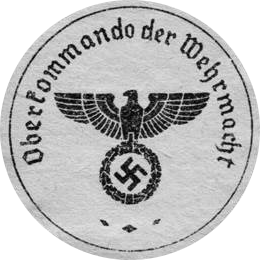
The Oberkommando der Wehrmacht was the supreme military command and control office of Nazi Germany during World War II. Created in 1938, the OKW replaced the Reich Ministry of War and had oversight over the individual high commands of the country's armed forces: the army, navy, and air force.

Konstantin Hermann Karl Freiherr von Neurath was a German diplomat and Nazi war criminal who served as Foreign Minister of Germany between 1932 and 1938.

The Rise and Fall of the Third Reich: A History of Nazi Germany is a book by American journalist William L. Shirer in which the author chronicles the rise and fall of Nazi Germany from the birth of Adolf Hitler in 1889 to the end of World War II in Europe in 1945. It was first published in 1960 by Simon & Schuster in the United States. It was a bestseller in both the United States and Europe, and a critical success outside Germany; in Germany, criticism of the book stimulated sales. The book was feted by journalists, as reflected by its receipt of the National Book Award for non-fiction, but the reception from academic historians was mixed.
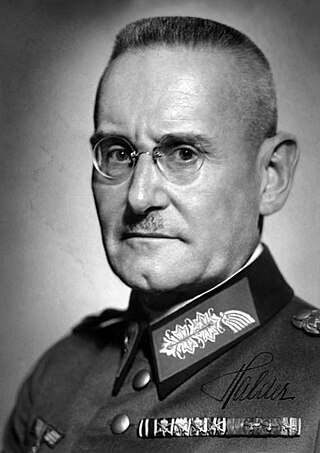
Franz Halder was a German general and the chief of staff of the Army High Command (OKH) in Nazi Germany from 1938 until September 1942. During World War II, he directed the planning and implementation of Operation Barbarossa, the 1941 invasion of the Soviet Union. Halder became instrumental in the radicalisation of warfare on the Eastern Front. He had his staff draft both the Commissar Order and the Barbarossa Decree that allowed German soldiers to execute Soviet citizens for any reason without fear of later prosecution, leading to numerous war crimes and atrocities during the campaign. After the war, he had a decisive role in the development of the myth of the clean Wehrmacht.
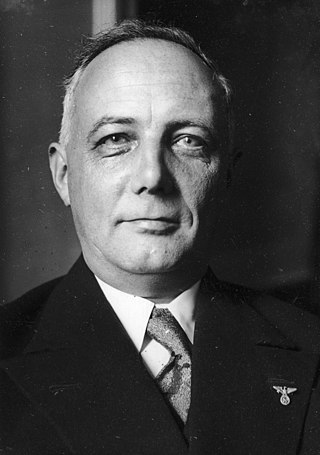
Hermann Adolf Reinhold Rauschning was a German politician and author, adherent of the Conservative Revolution movement who briefly joined the Nazi movement before breaking with it. He was the President of the Senate of the Free City of Danzig from 1933 to 1934. In 1934, he renounced Nazi Party membership and in 1936 emigrated from Germany. He eventually settled in the United States and began openly denouncing Nazism. Rauschning is chiefly known for his book Gespräche mit Hitler in which he claimed to have had many meetings and conversations with Adolf Hitler.
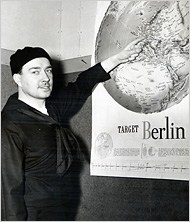
William Patrick Stuart-Houston was an English-born half-nephew of Adolf Hitler. Born and raised in the Toxteth area of Liverpool to Adolf's half-brother Alois Hitler Jr. and his Irish wife Bridget Dowling, he later relocated to Germany to work for his half-uncle before emigrating to the United States, where he received American citizenship and ended up serving in the United States Navy against his half-uncle during World War II, changing his surname after the war.

Thomas Ludwig Werner Freiherr von Fritsch was a member of the German High Command. He was Commander-in-Chief of the German Army from February 1934 until February 1938, when he was forced to resign after he was falsely accused of being homosexual. His ousting was a major step in Adolf Hitler's establishment of tighter control over the armed forces. Just over a year later, before the outbreak of World War II, Fritsch was recalled as Colonel-in-chief of the 12th Artillery Regiment. He died in battle in Poland early in the war; he was the second German general to perish in that conflict.

Although there is no evidence that Nazi leader Adolf Hitler used look-alikes as political decoys during his life, some dubious stories propagated before his demise alleged his death and replacement with an imposter. Following Hitler's suicide during the Battle of Berlin, the Soviet Union variously claimed that multiple bodies resembling the dictator were found. Contrarily, Western scholars conclude that the bodies of Hitler and Eva Braun were burned to near ashes, with only their dental remains confirmed to have been found.

Adolf Hitler was an Austrian-born German politician who was the dictator of Germany from 1933 until his suicide in 1945. He rose to power as the leader of the Nazi Party, becoming the chancellor in 1933 and then taking the title of Führer und Reichskanzler in 1934. During his dictatorship, he initiated World War II in Europe by invading Poland on 1 September 1939. He was closely involved in military operations throughout the war and was central to the perpetration of the Holocaust, the genocide of about six million Jews and millions of other victims.
Nazi Germany and the Nationalist government of the Republic of China maintained bilateral relations between 1933 and 1941. The Chinese Nationalists sought German military and economic support to help them consolidate control over factional warlords and resist Japanese imperialism. Germany sought raw materials such as tungsten and antimony from China. During the mid-1930s, thousands of Chinese soldiers were trained by German officers and German economic investment made its way into China. However, Joachim von Ribbentrop strongly favored an alliance with Japan over one with China, and starting with the 1935 Anti-Comintern Pact, Germany began to realign its East Asia policy. After Japan invaded China in 1937 and Ribbentrop became Foreign Minister the following year, German aid to China was cut off. In July 1941, Nazi Germany severed relations with Nationalist China and transferred their recognition to the Japanese-controlled Wang Jingwei regime. Nonetheless, China did not officially declare war on the Axis Powers until after the attack on Pearl Harbor.
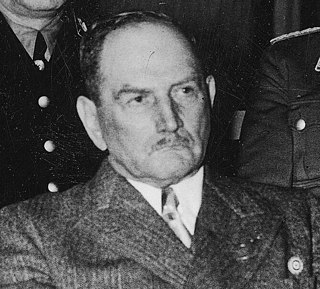
Franz Ritter von Epp was a German general and politician who started his military career in the Bavarian Army. Successful wartime military service earned him a knighthood in 1916. After the end of World War I and the dissolution of the German Empire, von Epp was a commanding officer in the Freikorps and the Reichswehr. He was a member of Bavarian People's Party, before joining the Nazi Party in 1928, when he was elected as a member of the German parliament or Reichstag, a position he held until the fall of Nazi Germany. He was the Reichskommissar, later Reichsstatthalter, for Bavaria, and a Reichsleiter of the Nazi Party.
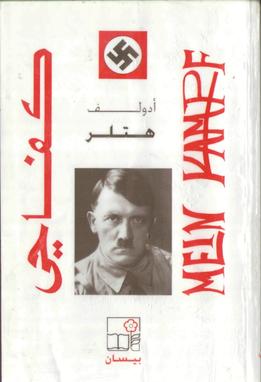
Mein Kampf, Adolf Hitler's 900-page autobiography outlining his political views, has been translated into Arabic a number of times since the early 1930s.
The Strange Death of Adolf Hitler is a 1943 American war film directed by James P. Hogan. The film follows a man who plans to murder Adolf Hitler and steal his identity.
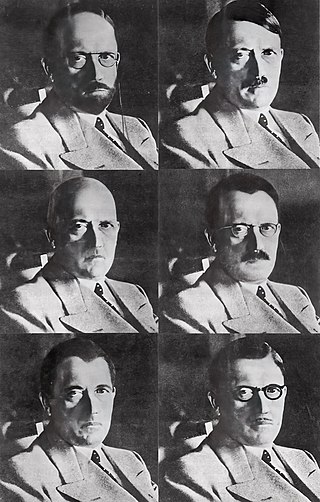
Conspiracy theories about the death of Adolf Hitler, dictator of Germany from 1933 to 1945, contradict the accepted fact that he committed suicide in the Führerbunker on 30 April 1945. Stemming from a campaign of Soviet disinformation, most of these theories hold that Hitler and his wife, Eva Braun, survived and escaped from Berlin, with some asserting that he went to South America. In the post-war years, the United States Federal Bureau of Investigation (FBI) and Central Intelligence Agency (CIA) investigated some of the reports, without lending them credence. The 2009 revelation that a skull in the Soviet archives long (dubiously) claimed to be Hitler's actually belonged to a woman has helped fuel conspiracy theories.
The following events occurred in March 1939:
Since the early 1930s, the history of Adolf Hitler's Mein Kampf in English has been complicated and has been the occasion for controversy. Four full translations were completed before 1945, as well as a number of extracts in newspapers, pamphlets, government documents and unpublished typescripts. Not all of these had official approval from Hitler's publishers, Eher Verlag.
References
- ↑ Anonymous 1939, p. 18.
- 1 2 "Author Declares He Impersonated Hitler". The Harvard Crimson . New York. 3 March 1939. Retrieved 27 June 2021.
- ↑ Anonymous 1939, pp. 378–381.
- ↑ Anonymous 1939, p. 7.
- ↑ Anonymous 1939, p. 8.
- ↑ Krauss, William (6 January 1939). "1939 01 14 066 TNY CARDS 000176404". The New Yorker. Retrieved 6 July 2021.
{{cite magazine}}: CS1 maint: url-status (link) - ↑ Anonymous 1939, p. 9.
- ↑ Anonymous 1939, p. 10.
- ↑ Woolbert, Robert Gale (8 October 2011). "Capsule Review: The Strange Death of Adolf Hitler". Foreign Affairs. ISSN 0015-7120 . Retrieved 27 June 2021.
Sources
- Anonymous (1939). The Strange Death of Adolf Hitler. The Macaulay Company – via the Internet Archive.